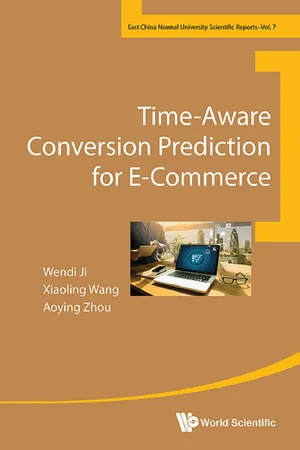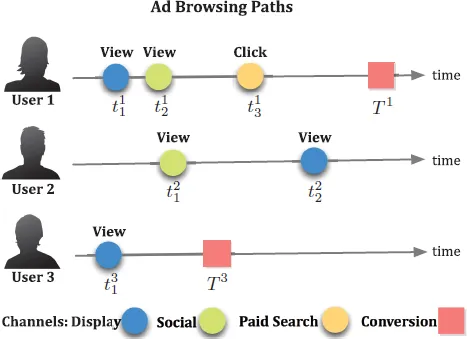![]()
Chapter 1
Introduction
The importance of computational advertising and product recommendation has been well recognized as a central task in business intelligence for e-commerce. Interestingly, what has been less well known is the fact that different products take different time periods for conversion. “Conversion” here actually refers to a more general set of predefined actions, including, for example, purchases or registrations. The mismatch between the product’s actual conversion period and the application’s target conversion period has been the subtle culprit compromising many existing advertising algorithms.
On the other hand, the other challenge of computational advertising is the attribution for conversions, which is also related to time. An online advertising campaign is usually launched across multiple channels such as display ads, paid search ads, social media ads, etc. The conversions of users are caused by the combined effect of the exposed ads within the journey. Therefore, Multi-touch attribution, which studies the effects of various types of online ads on purchase conversions, is a very important problem in computational advertising. It is worth noting that conversion time is highly related to the influence of an ad because customers are more likely to be affected by more recent ads. Borrowing the techniques of survival analysis and point process, some data-driven attribution algorithms based on the individual-level data of customers’ touch points can be used to assign credits for conversions to different advertising channels.
1.1The Research Framework on Time-Aware Conversion Prediction
The last decade has witnessed the generation of massive amounts of behavioral data on a daily basis thanks to the rapid development of computational advertising, online shopping, social media, and location-based services. These behavioral data reveal user preferences, needs, and consumption habits through their feedback from online advertising platforms and recommendation systems. Based on the feedback information, targeted advertisements or product recommendations could be delivered to the users who are more likely to respond. Conversion rate is usually used to measure the performance of advertising. In the advertising system, conversion refers to predefined behaviors such as purchases, registrations, and email subscriptions. In a commercial recommendation system, conversion is the consumption or rating of a recommended product. A core mission of computational advertising and recommendation is to optimize conversion rate prediction.
Traditional advertising systems and recommendation systems focus on finding the right user to deliver a piece of advertisement or the right product to recommend. However, in real applications, it is typical that the actual conversion rate also depends on the timing of the recommendation or advertising. For instance, recommending TVs to a user who has just recently bought a new one is likely to result in negative impressions as most consumers would not purchase another big-ticket item of the same kind, such as a car or a house, within a short period of time. They might consider replacing it or buying an extra one months or years later. A right product, recommended at a wrong time, is an opportunity hugely wasted. The pain is felt most acutely in product recommendation where users are disappointed by a recommendation list full of products unwanted at the time, which drives home the importance of time awareness in the performance of conversion rate prediction.
Moreover, the task conversion rate prediction in real life often comes together with a given time period constraint. Online shopping websites care most about products that will be bought in a particular upcoming period, such as one week or half a month. Advertising systems, especially those specializing in behavior retargeting, are more interested in users who are most likely to convert in near future. What is essential in all these scenarios is the ability to predict the conversion rate for a given period of time. The question we should answer is not just whether it is the right product to recommend but also whether it is the right time to recommend.
Heuristic approaches [1–3, 75] have been proposed to improve recommendation performance with temporal information. They focused on selecting the right items in which timing is treated just as temporal characteristics to improve the prediction accuracy, e.g. holiday seasons are found to be the favorite time for shopping [4]. Lifetime models are also used in recommendation and advertising systems [28–30, 34].
On the other hand, the other challenge which we focused in this chapter is attribution analysis for conversion. Firms launch an advertisement campaign through various channels, such as display ad, video ad, social ad, paid search ad, etc. Attribution technology is designed to help marketers understand how particular channels contribute to user conversions, which is now being seen as integral to the future of digital advertising. A promising attribution model is of great help for marketing managers to interpret the influence of channels and optimize their advertising strategies. It is worth reminding that the temporal information is also of great importance to analyze the true contribution of each ad or recommendation, for the reason that users are likely be influenced by recent ads.
In an online advertising campaign, users are exposed to ads with various channels, as illustrated in
Figure 1.1. Suppose that a company
X launches an advertising campaign through three channel: display ad, social ad, and paid search ad. User 1 saw
X’s display ad at
when browsing a webpage and then saw
X’s social ad at
. Later, she/he searched for products and clicked
X’s paid ad link at
. Finally, she/he made a purchase on
X’s website at time
T1. How shall we evaluate the contribution of the three ads to the conversion?
Post-click attribution is one of the earliest and simplest attribution models, which assigns all credit to the last ad clicked before a conversion. It has been considered as the standard attribution model in digital advertising industry. For User 1, if the last click wins, the overall contribution is assigned to the paid search ad and the effects of former viewed ads are totally ignored. Despite its simplicity, this attribution mechanism over-values the contribution of search ads and neglects the influence of the ads before the ‘last click’. In fact, the some queries triggering paid search ads are special ‘conversions’ due to previously viewed ads. Furthermore, in many cases, user never clicks before conversion. A reliable attribution mechanism should consider the contributions of all relative ads in the consumer journey.
Fig. 1.1 Customer journeys on an advertising campaign. Each journey is composed of a chronological sequence of actions by a user on three advertising channels, including display ad, social ad, and paid search ad.
Users’ behaviors are caused by the combined effect of the exposed ads within the journey. Multi-touch attribution (MTA) allows marketers to capture real return of investment (ROI) for multiple advertising touch points. It has become a significant research topic and has been explored by several online marketing analytics companies (e.g. Google Analytics,1 Nielsen2). Comparing the ROI based on different MTA models, advertisers evaluate the contribution of different channels and, furthermore, decide how to allocate their budget to various channels in the next stage. Some rule-based MTA models have been proposed in practice, e.g. linear attribution model, time decay attribution model, and position-based attribution model. However, the main drawbacks of these rule-based models are the subjectivity of hypotheses. In recent years, several data-driven attribution models have been proposed in computational advertising [35–37] and marketing analytics [38, 39].
1.2The Present State and Prospects
In this section, we introduce the present researches and prospects of conversion prediction and contribution analysis in the existing applications.
1.2.1Computational Advertising
Computational advertising is an emerging new scientific sub-discipline, at the intersection of large-scale search and text analysis, information retrieval, statistical modeling, machine learning, classification, optimization, and microeconomics. The central problem of computational advertising is to find the “best match” between a given user in a given context and a suitable advertisement. The context could be a user entering a query in a search engine (“sponsored search”), a user reading a web page (“content match” and “display ads”), a user watching a movie on a portable device, and so on. The information of a user can either be very detailed (a user with lots of behavior date) or not exist (a cold start user). The number of potential advertisements might be in the billions. Thus, depending on the definition of “best match” this problem leads to a variety of massive optimization and search problems, with complicated constraints and challenging data representation and access problems [83].
With lasting growth of Internet users and more abundant online applications, Internet has become the leading advertising medium. Companies spare no effort to attract consumers to visit their websites via online advertising. In United States, online advertisers spent $59.6 billion for the full year of 2015, up 20.4% from $49.5 billion reported in 2014 [60]. Computational advertising is a principled way to find the “best match” between a user in a given context and a suitable advertisement. Targeting techniques make personalized advertising possible. Based on the contextual information and user feedback data, online advertising systems deliver ads to the users who are most likely to respond.
Online advertising offers the advertisers a wide range of payment options. If the goal of an advertising campaign is getting their message to the target audience (for instance in brand awareness campaigns), then the paying per impression (CPM) with targeting constrains is normally the appropriate choice for advertisers. However, many advertisers would prefer not to pay for an ad impression unless the impression leads the user to their websites. Performance-dependent payment models, such as cost-per-click (CPC) and cost-per-conversion, were introduced to address the concern. Under the CPC model, advertisers will only be charged if the users click on their ads. Cost-per-conversion, also known as cost-per-action (CPA), is a payment model where the advertiser pays for each specified action. The “conversion” here refers to actually a more general set of predefined actions, including for example form submissions, purchases, or registrations. The cost-per-conversion option reduces the advertisers risk even further by allowing them to pay only if the user takes a predefined action on their website. To support such conditional payment options, advertising platforms need to convert the bids of advertisers to expected price per impression (eCPM). The eCPM of CPC and cost-per-conversion bid, will depend on the probability that the impression leads to a click or conversion. Therefore, the estimation of the probabilities, click-throug...




